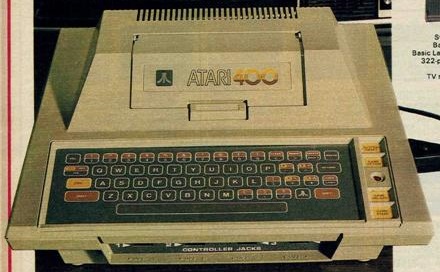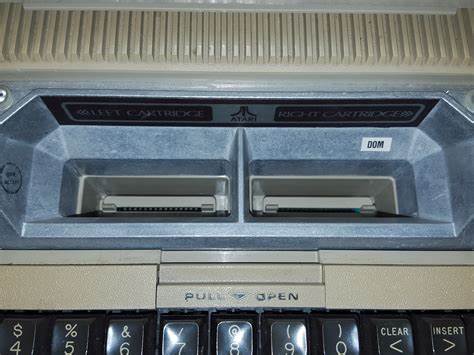Triple-Crossroads
During development of the 2600 in 1976, Atari's engineering team, including Joe Decuir, Jay Miner, and Steve Mayer, predicted it
would be outdated within the next three years. After Atari founder and CEO Nolan Bushnell sold the company to Warner
Communications, there was enough money to finish the 2600's development and release it. It was at this point the team explored
designs for a system that could succeed it by 1979. They came up with three different machines. The first, codenamed Candy, was a
game console similar to the 2600, but with more sophisticated graphics and sound and a faster CPU. It was also without a keyboard
or input/output ports. Second was an actual home computer, called Colleen. This would've been expandable and featured peripheral
ports, RF and monitor video outputs, and a familiar typewriter-style keyboard. Third was a seldom-known concept called Elizabeth,
which would've been a Colleen with a 13-inch color monitor built-in. This one's a mystery to me, as it sounds like a Commodore PET
with color and a considerably larger screen.
Yar's Arrival
In 1978, as the new computers' chips were being developed, Warner chose Ray Kassar to be CEO of Atari. Ray believed the new chips
would be best implemented in "a" new home computer to challenge the "1977 Trinity" of microcomputers (the PET, TRS-80, and Apple
II), which were more expensive and had higher profit margins, but inferior hardware. So, Atari ditched the Elizabeth concept and
turned Candy and Colleen into two different budget home computers.
New Weaponry
When the engineering team completed development of the new technology, it came in the form of three new chips: the CTIA; the ANTIC;
and the POKEY chip. The CTIA used actual sprites and background graphics, unlike its predecessor the TIA which had to draw the
background data loaded in by the CPU. Also unlike the TIA, it doesn't communicate with the main CPU. Instead, it communicates with
the ANTIC chip, which gathers sprite memory from RAM and scanline data from a framebuffer. That's when the CTIA takes it and
outputs the color, sprite, and graphical data. Last, the POKEY chip. Originally, in addition to providing the highly sophisticated
sound the 8-bit line was known for, the chip would've communicated with the paddle controllers and keyboard. This plan owes itself
to the POKEY's name being a portamenteau of input/output devices "POtentiometer", how the computer communicates with the paddle
controllers, and "KEYboard". It had four different sound channels with adjustable volume, frequency, and waveform.

Candy, newly named the 400, was made for children first getting acquainted with computers. It had a membrane keyboard that couldn't
easily be damaged by spills and extra memory expansion bays behind the cartridge lid, out of easy reach from the user.

Colleen, newly named the 800, was made more or less the same as it was conceived to be. It had the proper typewriter-style keyboard.

What makes the 800 different from the 400 and all their successors is it has two cartridge slots side-by-side. One is labeled "left
cartridge" and the other is labeled "right cartridge". Each cartridge game or program made for the Atari computers was also labeled
to indicate which slot it was for. 99.9% were made for the left slot, and almost none were for the right slot to act as an
expansion for a compatible left slot cartridge. An example of a right-slot cartridge is the Monkey Wrench, which acts as a machine
language monitor and adds commands to a connected Atari BASIC inserted cartridge.
Pre-Acti-visionaries, Go!
In anticipation of Winter CES 1979 where Atari would showcase the two computers, senior developers such as Alan Miller, Larry
Kaplan, Bob Whitehead, and David Crane were tasked with writing the 800's operating system. If those names sound familiar, they
would all leave Atari and start a third-party game developer called Activision at the end of the year.
They Run Loose
Atari began the shipment of the 400 and 800 in November 1979. The numbers in the names originally indicated the amount of RAM they
came from the factory with: 400s had 4 KB and 800s had 8 KB. Over time, RAM prices fell, leading to both models being released with
8 KB. Eventually, the 400 started coming out with the maximum 16 KB and the 800 with 48 KB. Unlike almost all computers at the
time, the 400/800 had four controller ports! As this was shortly before the Commodore VIC-20 and Tandy Color Computer were released
with at least one, this was another impressive feature.
The two computers were praised for their entertainment and productivity software and sophisticated graphics capabilities. The 800
was particularly praised for its resilient construction, informative manuals, and how good the keyboard feels to type on. A
weakness that led some to say it "hasn't reached its full computing potential" is the amount of software and peripherals that were
available within the first year the pair were on the market, compared to the Apple II and TRS-80 business machine, despite the
latter pair coming out two years earlier than the 400/800.


In the end, twice as many 400s were purchased compared to 800s. As greater competition emerged in the form of the Commodore 64 and
other more advanced computers, these original models of the 8-bit line would be succeeded by several more models throughout the
next decade.


 Candy, newly named the 400, was made for children first getting acquainted with computers. It had a membrane keyboard that couldn't
easily be damaged by spills and extra memory expansion bays behind the cartridge lid, out of easy reach from the user.
Candy, newly named the 400, was made for children first getting acquainted with computers. It had a membrane keyboard that couldn't
easily be damaged by spills and extra memory expansion bays behind the cartridge lid, out of easy reach from the user.
 Colleen, newly named the 800, was made more or less the same as it was conceived to be. It had the proper typewriter-style keyboard.
Colleen, newly named the 800, was made more or less the same as it was conceived to be. It had the proper typewriter-style keyboard.
 What makes the 800 different from the 400 and all their successors is it has two cartridge slots side-by-side. One is labeled "left
cartridge" and the other is labeled "right cartridge". Each cartridge game or program made for the Atari computers was also labeled
to indicate which slot it was for. 99.9% were made for the left slot, and almost none were for the right slot to act as an
expansion for a compatible left slot cartridge. An example of a right-slot cartridge is the Monkey Wrench, which acts as a machine
language monitor and adds commands to a connected Atari BASIC inserted cartridge.
What makes the 800 different from the 400 and all their successors is it has two cartridge slots side-by-side. One is labeled "left
cartridge" and the other is labeled "right cartridge". Each cartridge game or program made for the Atari computers was also labeled
to indicate which slot it was for. 99.9% were made for the left slot, and almost none were for the right slot to act as an
expansion for a compatible left slot cartridge. An example of a right-slot cartridge is the Monkey Wrench, which acts as a machine
language monitor and adds commands to a connected Atari BASIC inserted cartridge.

